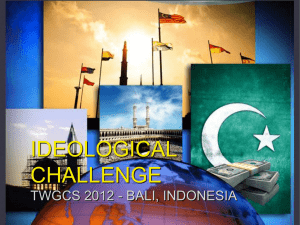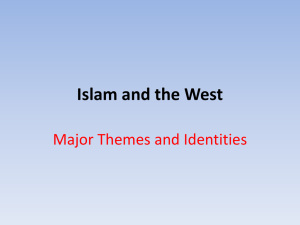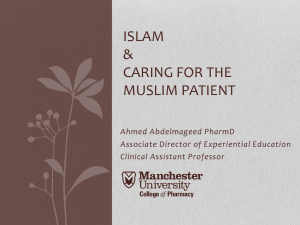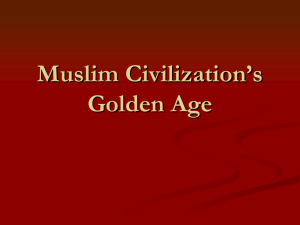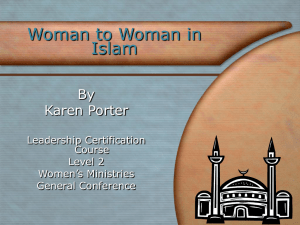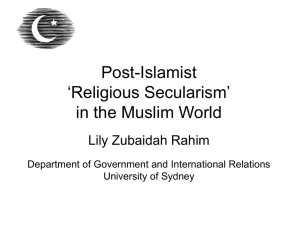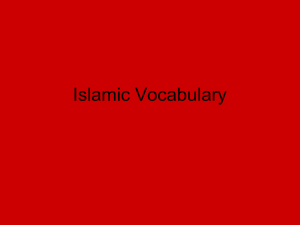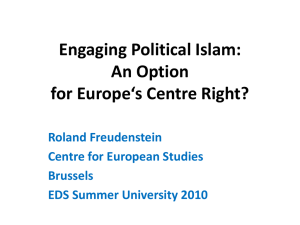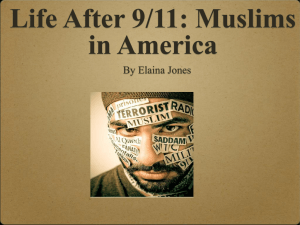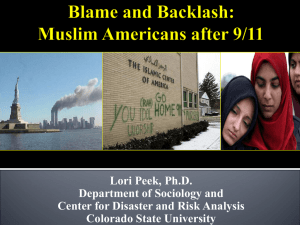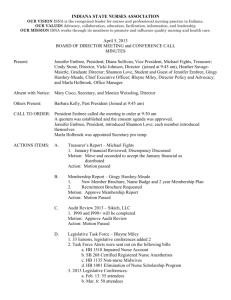25 Ahmed
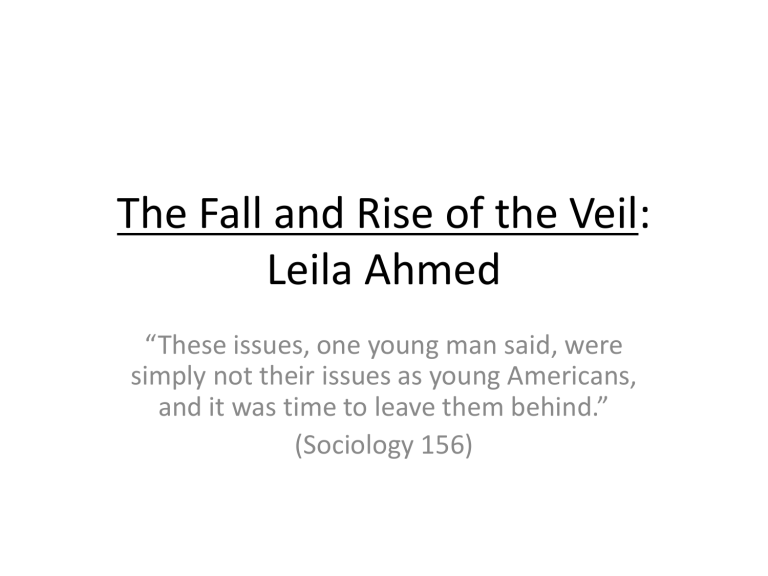
The Fall and Rise of the Veil:
Leila Ahmed
“These issues, one young man said, were simply not their issues as young Americans, and it was time to leave them behind.”
(Sociology 156)
Post-9/11
• A rash of violence against Muslims, esp. against women in hijab
– President Bush: Women who cover their heads should not fear leaving their homes. That’s not the America I know.
– Invites head of ISNA to read from the Quran as part of
9/14 nat’l memorial service at nat’l cathedral
• Attacks on Islam in the public media, particularly from figures associated with the Christian right
– Franklin Graham, son of Billy Graham: Islam a “very wicked, evil religion”
– Jerry Falwell describes Mohammed as a terrorist
– Ann Coulter: “We should invade their country, kill their leaders, and convert them to Christianity.” (194-200)
2
Post-9/11
• Women’s oppression in Islamic world, and symbols such as veils and burka, become recurrent themes in public conversation & political debate & legitimation for war
– Laura Bush: “Civilized people throughout the world are speaking out in horror—not only because our hearts break for the women and children of
Afghanistan, but also because in Afghanistan we see the world the terrorists would like to impose on us.
The fight against terrorism is also a fight for the rights and dignity of women.” (195)
3
Post-9/11
• Reports of assault & bias against Muslims (and suspected Muslims, Sikhs and Arab Christians) rises 1,600% after 9/11
– Arson, beatings, vandalism, murder
• Also support: 2002 CAIR survey reports 80% Muslims report kindness & support from members of other faiths, 57% bias and discrimination
– After San Diego Islamic center & mosque attacked, cards, bouquets, & support, esp. after reports of women being afraid to leave home
• Interest in Islam surges, books on the subject become popular
• On the defensive, mosques open themselves for informative sessions on
Islam
– “I felt that I was present at a new moment in history—in the history of Islam as well as of America. It seemed an augury of the opening up of a new kind of public space in which not only ordinary Muslims but also Muslim authorities were respectfully hearing out the views of those who spoke from completely different worldviews” (200-204)
4
Post-9/11
• Harassment, violence intensify, as do efforts at support
– “Headscarf days”, very controversial, alleged to embrace
Islam’s oppression of women
• Some Muslim women who had not worn the scarf begin to do so
– Act of defiance, solidarity w/Muslims worldwide, esp. with
Palestinians
– The hijab as “an act of solidarity with Muslim women all over the world. Here I am an educated Muslim woman in the West, and even though I have no idea what it’s like to be an Iraqi, Bosnian, Somalian, or Palestinian woman, I know that we share an identity through Islam and through the hijab.”
5
Post-9/11
• The social meaning of a symbol depends on its historical, cultural, religious, and political context
– The hijab has a different (though related!) meaning in post-9/11 USA than in
1970s Egypt, and different than in contemporary Afghanistan
– In Cairo, protest against perceived material and moral corruption, in the US, response to prejudice and discrimination, as well as to say, ‘I also am an
American.’
• “In both societies wearing hijab became a sign and banner of a call for justice” that enable a minority to recognize & support one another
– Identity with the global Islamic community
– Reasons given for wearing hijab both highly personal yet generically similar, “a way of signaling a call for justice in whatever aspect of it was in the foreground for the wearer.”
– But context dependent: The veil could not stand for equality of minorities & gender equality, as it does for some American Muslims, in Cairo or Tehran
– At the same time, a sign of the Other and the oppression of women to many
Westerners (210-213)
6
Post-9/11 bias against Muslims
• Immediately after, 1,200 Muslims arrested & detained w/o charges
• Suspicion, compelled to affirm loyalty to US
– A period when disagreement w/gov’t was regarded in some circles as treasonous
• Reports to FBI because “too many Muslims worked at the convenience store” or Muslim neighbor kept odd hours
• Canadian citizen Maher Arar rendition to Syria, tortured for a year
• Homes raided by armed federal agents, some get PTSD
• Abuses at Abu Ghraib, Guantanamo
• Letter writing campaigns against Muslim professionals & academics (214-220)
7
Post-9/11 bias against Muslims
• Islamo-Fascist Awareness Week
– Speakers include Rick Santorum, Ann Coulter, Sean Hannity
– Seem to be concerned primarily w/the rights of only women who are Muslims
• Not only on the right: Chris Matthews: They hate us
“because our culture teaches us to respect women.”
• “White men saving brown women from brown men.”
– “Many academics, as I noted, were shocked at the blatant coopting of the issue of oppression of ‘women in Islam’ in the service of imperial wars and domination.” (221-224)
• Empire?
8
Post-9/11 bias against Muslims
• Instead of a political and historical explanation for terror and oppression of women in Afghanistan, a search for cultural and religious explanations
• “Native testimonials”
– Azar Nafisi, Reading Lolita in Tehran (2003)
– Irshad Manji, Trouble With Islam (2004)
– Ayaan Hirshi Ali, Caged Virgin (2006
– Manji & Hirshi Ali’s book riddled w/inaccuracies
• Voices of these women more powerful in generating consent to war than non-native authors would have been (224-227)
9
Women in Islam
• “Today there is no intelligible overall subject of
‘women in Islam’ any more than there is an intelligible overall subject of ‘women in
Christianity’ that might usefully account for the conditions of women in sub-Saharan Africa,
Russia, Korea, South America, and the United
States.”
– “The reality is that the conditions of Muslim women and what they are ‘oppressed’ by varies enormously depending on the political conditions in specific moments in time in different countries” (230-231)
10
ISNA post-9/11
• Actively cooperates w/US gov’t on security concerns
– “Zero tolerance for the fanatics and bigots among us”
“forceful condemnations of terrorism”
• Offers pro bono legal services for immigrants who faced problems from 9/11 backlash
• An organization by and for Americans: “If you want to know if you’re going home or not, just listen to the accent of your kids, then you’ll know that you’re not going anywhere.”
– Intertwining of Islam w/American political beliefs & traditions
– Speakers often invoke Martin Luther King (236-239)
11
ISNA post-9/11
• Ingrid Mattson becomes first female president of ISNA (on 9/2/11)
– Muslim women need to make clear that “no one is beating you up to make you wear a scarf.”
– Increasing visibility of women on convention panels
• “New spaces were opening up at these conventions for direct criticism of the official stances and practices of the organizations— in relation specifically to women but also to other matters.”
– Shock of 9/11 puts institutions on defensive, forces to hear internal criticism they may previously have dismissed.
– Sex segregation present, but laxly observed: Earlier conventions “had projected a sense of male dominance and of gender hierarchy as a foundational value that was ostentatiously and unapologetically asserted. Now this sense was eroding and being challenged.” (246-48)
12
ISNA post-9/11
• A generation gap emerges
– Demands for equal representation of men & women in leadership
– Complain about sex segregation, as it does not fit the lived experience of American young people
• Veiling more laxly observed
– “Others complained about foreign policy issues, in particular that their parents seemed obsessed with political matters affecting their home countries. But these issues, one young man said, were simply not their issues as young Americans, and it was time to leave them behind.”
– New religious perspectives represented that (at least implicitly) challenge ISNA positions (247-248)
13
ISNA post-9/11
• At Muslim WakeUp! complaints that ISNA “run mostly by first generation immigrant Muslims with cultural baggage from their homelands,” and so “ISNA management has been unable to relate to their American-born Muslim constituency which is the future of Islam in America.”
• Also, a tendency “to enforce a particularly religiously conservative philosophy without adapting to the people it serves.”
– “Women presenters at ISNA have been routinely asked to wear hijab during presentation even though they don’t normally wear the headscarf. This has promoted either hypocrisy or contention when presenters have refused to wear it.” (255)
14
ISNA post-9/11
• “The fact that the majority of Muslim activists today, even in relation to gender issues, appear to be drawn from [a] very specific and distinctive Islamist-influenced segment of the
American Muslim population population is. . .
. a remarkable and unexpected finding.”
– Work on social justice issues
– Questions of sex equality
• In society at large
• In Muslim societies specifically, even at mosques (253)
15
